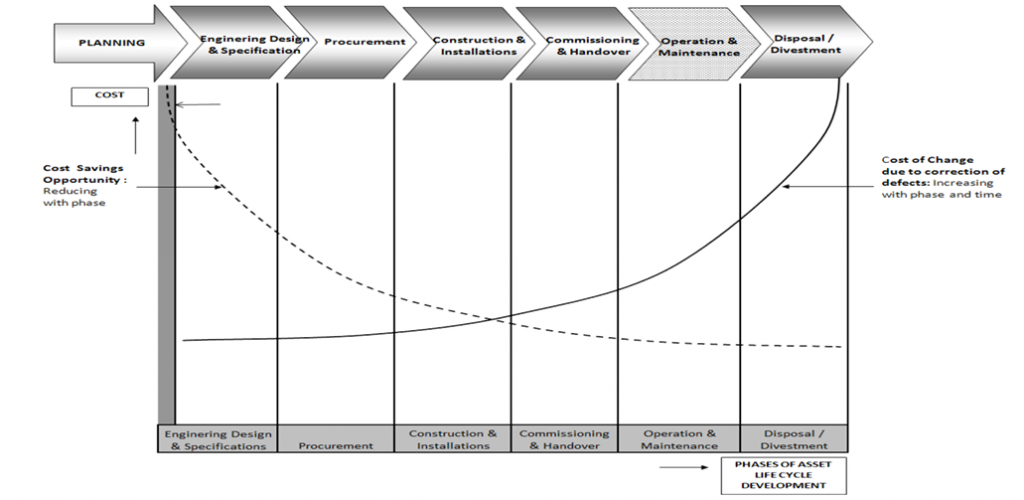Facilities Management is responsible for up to 70 and 80 percent of the total lifecycle of a Real Estate asset. It therefore goes without saying that if an investor or building owner is able to save cost across 70 percent of his/her asset lifecycle, the benefit in terms of business bottom line and asset performance is huge.
For Facilities Management to be able to indeed save costs for Real Estate investors or owners, then it must have been involved in the initial 20 to 30 percent of the Real Estate lifecycle; which typically is the planning, design, construction and commissioning stages of the building.

Diagram 1: Cost-Saving Impact of Facility Management On Various Stages of Asset Life Cycle
For example, one of the recent trends in the Nigerian Real Estate Sector is the increased rate of building dilapidation and structural failures. Over 56 cases of building collapse were recorded in the past four years.
According to a report by the International Journal of Civil Engineering and Technology (IJCIET), Covenant University, root cause analysis carried out shows that these incidents are generally as a result of poor building materials on one hand; and poor maintenance of these buildings on the other hand.
One thing one could establish with this trend is that that the loss of investment could have been averted if the right Facilities Management Strategies were in place.
This goes to demonstrate the importance of Facilities Management through the lifecycle of Real Estate assets. From conception to design, operations, and disposal, involving Facilities Management doesn’t just save cost, it majorly impacts the outcome and lifecycle of a structure.
Having the Facilities Management team at the conception stage of an asset, has a potential to help achieve maximum functionality and increasing cost saving opportunities for the asset.
As seen in the diagram above, the earlier Facilities Management is involved in the Real Estate lifecycle, the higher the opportunities for saving and optimizing costs.
When involved from the conception and design state, Facilities Management would be able to control and address issues that may arise in the later years of operating a building and enable the implementation of preventive maintenance models in the design plan to reduce the cost of operations.
How Facilities Management Can Save-Costs at the Different Stages of Real Estate Lifecycle
- Planning & Design:
Putting Facilities Management in view when planning a Real Estate project helps determine that nature or class of Real Estate asset to be built. For example, Facilities Management can guide when it comes to the type of building to be erected in certain location and how such building should be conceived in design.
Thinking through these from the planning level helps put everything in perspective from the beginning. This will help minimize unnecessary cost of rework. Facilities Management techniques, and deeper understanding of the built environment, also helps in improving the design output and increases the design efficiency.
Facilities Management can also help through procurement of the right building materials. It will not just help with quality procurement; it also helps with economy of scale.
- Occupiers Experience
It is now an established fact that the workplace environment or where people live contributes to their level of productivity.
When Facilities Management plays a significant role in the output of where people live work and play, it is expected that the increased productivity has a potential of translating to better revenue performance for their businesses.
- Installation and Commissioning
These are two very important stages in the asset lifecycle. Getting Facilities Management involved at any of these stages is critical to cost saving. For example, the type of installations could determine the frequency of repair, rework and replacement.
Also, Facilities Management is important commission and hand over stage because it can ask the construction team the right questions and request for the right documents that will make maintenance of the building cost-effective in the long run. a


